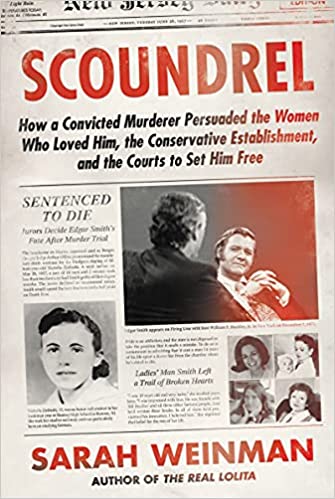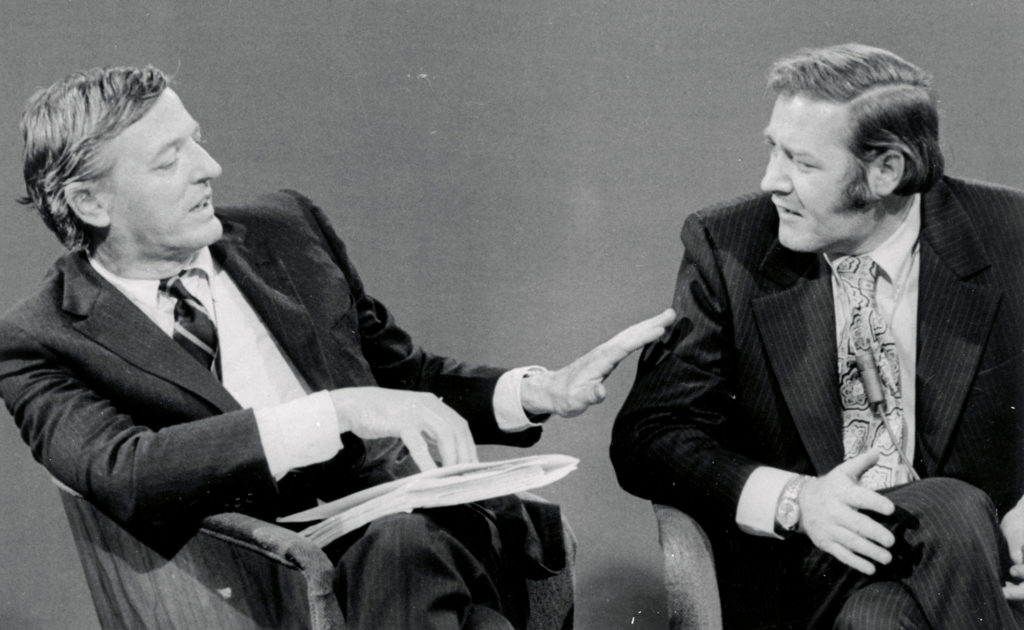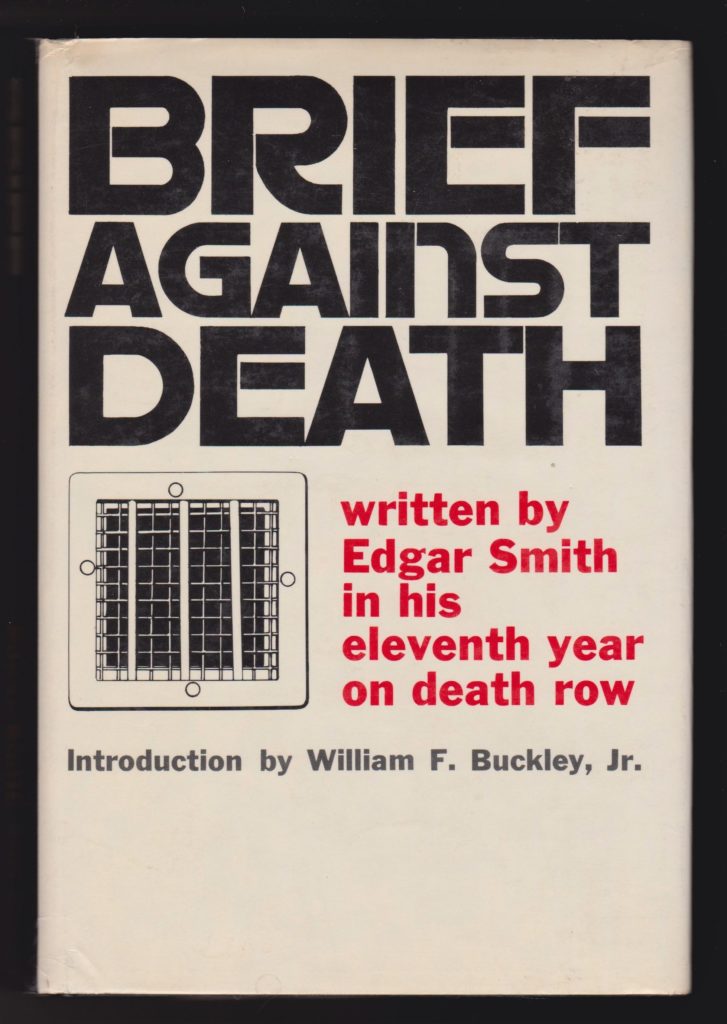Scoundrel: How William F. Buckley Learned That Evil Is Real
Even the most sagacious among us can be snookered by manipulative con men.
This essay originally appeared in Law & Liberty on April 27, 2022 (here). Thanks to Instapundit (here), Power Line, Real Clear Policy (here), the Leighton Smith Podcast (here), and Real Clear Books (here)! I’m honored that the editors selected this essay as one of “Our Best of 2022” (here).
The literati sometimes look down on the genre of “true crime,” but it remains enormously popular (In Cold Blood was by far Truman Capote’s best-selling work) and, if done well, can teach us important lessons about human nature, the criminal justice system, and the foibles of celebrity. Sarah Weinman’s Scoundrel (2022) recounts the tale of Death Row inmate Edgar Smith and his unlikely friendship with William F. Buckley. Smith, then 23, was convicted of brutally murdering a 15-year-old New Jersey girl, Victoria Zielinski, in 1957, so the saga also serves as a period piece set in post-WWII America. Scoundrel is fascinating, and instructive, on several different levels.

As an exercise in nostalgia, the book provides a heart-warming reminder that murders were once rare enough to create a sensation in communities when they occurred, even in suburbs of major cities, such as Bergen County, New Jersey. With the help of cooperative witnesses and energetic law enforcement, crimes were often rapidly solved, confessions (in the pre-Miranda era) were routine, and justice was swiftly meted out. In Smith’s case, he was arrested within days of the murder, quickly implicated himself under police questioning, and was tried, convicted, and sentenced to death within four months after the crime. Following a two-week-long trial, at which Smith testified unconvincingly in his own defense, the jury returned its verdict in less than two hours. Smith was scheduled for execution (to be administered by the electric chair) on July 15, 1957.
Criminal proceedings today, by contrast, move at a snail’s pace. Alas, Smith lived another 60 years, dying of natural causes on March 20, 2017 at age 83 in a California state prison.
What happened during those intervening six decades forms the engrossing substance of Scoundrel. It will not spoil the reader’s enjoyment of Weinman’s dramatic narrative to share the highlights. Smith’s incessant appeals benefited from the criminal law revolution wrought by the Warren Court following his conviction. An open-and-shut case in 1957 became a minefield of constitutional issues as a result of the Supreme Court’s cornucopia of pro-defendant rulings during the 1960s. Eventually, in 1971, Smith’s unsigned (but transcribed and tape-recorded) confession–a damning mélange of self-serving lies, blame deflection, and preposterous flip-flops—was deemed to have been coerced, and after fourteen and a half years on Death Row his conviction was reversed.
Rather than insist on a retrial to establish his long-professed innocence, Smith agreed to plead non vult—no contest–to (and admitted the key details of) the murder. With credit for time served and sentence reduction for “good behavior,” Smith was immediately released from prison and placed on parole. So far, the story is unremarkable. Many convicted criminals during the 1960s eluded their original sentences due to similar legal maneuvering made possible by liberal judicial decisions. What makes Smith’s case so absorbing is that he was a cunning sociopath and indefatigable letter writer with a facility for glib prose, who was able to educate himself while in prison to acquire enough intellectual patois to manipulate his various pen pals into believing him to be a wrongfully-convicted innocent. (Smith blamed the murder of Victoria Zielinski on a mutual acquaintance, Don Hommell.)
One of the victims of Smith’s extraordinary con job was National Review founder William F. Buckley, who befriended Smith in 1962. Adept at flattery and posing as a conservative, Smith caught Buckley’s attention by complaining that he had lost access to National Review on Death Row. Buckley promised Smith a free, life-time subscription. Over the next decade, Buckley and Smith exchanged hundreds of letters—comprising over 1,500 pages of correspondence. Weinman has read them all. Deftly-chosen excerpts allow the reader to eavesdrop on the intimate banter between the nation’s leading conservative and a convicted murderer who would become the nation’s longest-serving Death Row inmate—eclipsing the record of Caryl Chessman, who was executed in 1960.
Buckley became more than Smith’s pen pal; he eventually served as Smith’s confidant and tireless champion. Convinced of Smith’s innocence, Buckley wrote several columns about Smith’s case. In 1965, Buckley wrote an article about Smith’s plight for Esquire, using the fee he earned to start a legal defense fund for Smith. Buckley found lawyers to work on Smith’s appeals; introduced Smith to a book editor who helped Smith publish a widely-read book in 1968 (Brief Against Death) depicting himself as a wrongfully-convicted victim; and promoted Smith’s book with appearances on major television shows such The Tonight Show. It is fair to say that Buckley’s efforts were largely responsible for Smith becoming a celebrity and, later, gaining release from prison in New Jersey.
Beguiled by Smith’s unctuous erudition and well-rehearsed claims of innocence—Death Row inmates can devote years to refining their elaborate exculpatory scenarios—Buckley enthusiastically adopted Smith’s cause as his own. When Smith was finally released from prison in December 1971, Buckley picked him up in a chauffeur-driven limousine, uncorked a bottle of wine and toasted to Smith’s liberation, and whisked him to a television studio in New York City to record Smith’s appearance on two hour-long episodes of Firing Line, which aired on consecutive weeks. When the taping was concluded, Buckley hosted a party for Smith at his Upper East Side maisonette. Buckley was heavily invested in Smith’s claims of innocence.

With this launch, Smith embarked on a brief literary career that included reviewing books for Playboy, giving speeches, writing for the New York Times and other publications, making appearances on The Mike Douglas Show and similar programs, and writing a couple of (less-successful) follow-up books. The fame quickly dissipated. Smith’s post-release celebrity status lasted longer than did Norman Mailer’s protégé, Jack Henry Abbott, a convicted murderer who killed again six weeks after being paroled from prison in 1981, but the result was the same.
Smith was, after all, a violent sociopathic misfit ill-suited for life outside of prison. In October 1976, less than five years after his triumphant release from Death Row, Smith—now estranged from Buckley and living in San Diego—abducted, attacked, and nearly killed another female victim, Lisa Ozbun. Smith fled but was eventually captured. (Buckley, whom Smith had called for help, turned him in to the FBI.) At his trial the following year, his guilt established beyond dispute, Smith took the stand and admitted that he was a sexual predator who had killed Victoria Zielinski in 1957 after all.
Some observers speculated that Smith’s motive in confessing to the Zielinski murder (and a prior attempted molestation of another girl as a teenager) was self-serving. He faced no additional punishment for murdering Zielinski because he had already been convicted of that crime. For the abduction and attempted murder of Ozbun, California law contained an anomaly. If the court found that Smith was guilty of “aggravated kidnapping with intent to rape,” he would face a lesser sentence (and the possibility of parole), than if he were convicted of kidnapping with intent to rob, for which parole was not possible. Even though Smith—unemployed and broke—had abducted Ozbun to steal her paycheck, the ever-cunning Smith tried to manipulate the court into believing his motive was rape, in order to receive a more lenient sentence. Smith’s scheme didn’t work; the court sentenced him to life without parole, and he eventually died in prison—decades later.
Buckley understandably felt betrayed—and embarrassed–by Smith following the Ozbun attack and publicly recanted his belief in Smith’s innocence. In November 1976, he wrote in his syndicated column that “I believe now that [Smith] was guilty of the first crime.” In a 1979 article for Life, Buckley went further, explaining that he had been fooled by Smith’s “social savvy and wit,” and acknowledging that Smith’s release from prison, which Buckley had enabled, was “truly tragic.” Buckley never spoke of Smith again.
I recite this story not to disparage Buckley, whom I have long regarded as one of the most intelligent and articulate thought leaders on the American Right, but to illustrate that even brilliant conservatives can indulge in credulous gullibility and naiveté. (Buckley was not alone in falling for Smith’s wiles; Smith’s editor was also seduced by his feral charm.) Smith’s story about what happened in 1957 was, and had always been, ludicrously far-fetched. Smith admitted that he picked up Zielinski in a borrowed car the night that she was killed, took her to the murder scene (a sand pit), and struck her. He discarded his shoes and blood-stained pants after the encounter. When Smith returned the car to its owner, it contained blood stains. Hommell, whom Smith risibly claimed was the actual killer, had an alibi. Smith’s unsigned statement to the police departed in material respects from his dubious trial testimony. The jurors in 1957, who had the opportunity to evaluate Smith’s demeanor and credibility on the witness stand, rejected his story in toto. Evidence of his guilt was overwhelming.

Even Smith’s magnum opus, his self-serving account in Brief Against Death (1968), failed to persuade me when I read it as a teenager. Smith’s implausible story, overly detailed in some respects and suspiciously vague in other, simply didn’t ring true; it defied belief. It sounded like a lie, because it was a lie. (Truman Capote always felt that Smith was guilty, telling Buckley “I never met one yet who wasn’t.”)
The moral of this tragic story is that people are often too trusting of criminals professing their innocence, and ignore the reality of human nature: Evil exists. Heinous crimes don’t commit themselves. Some people are capable of unspeakable acts. As hard as it may be to contemplate, murderers and other predators can be normal-looking, intelligent, and engaging—even conservative! Nearly all criminals convicted of a crime are actually guilty. Juries do not generally convict arbitrarily. Instances of innocent people getting convicted (beyond a reasonable doubt) for a crime they didn’t commit are exceedingly rare. Offenders deserve to be punished. Exculpatory claims by prisoners—regardless of race–must be treated with skepticism. Yet, smart people sometimes get deceived by schemers like Smith. Why?
Weinman’s theory is that “Humans are hardwired to believe what other humans tell them.” My own reaction is slightly different. It is easy to succumb to wishful thinking—to suspend one’s disbelief—by ignoring the reality of human nature. Pretending that evil doesn’t exist is a form of utopian thinking. Even sound conservatives and morally-grounded believers can acknowledge the abstract concept of evil without recognizing its presence in their midst—sometimes failing to apprehend what is staring them directly in the face. Yet evil always manifests itself through human agency. Not everyone tells the truth. Not everyone is innocent. Professions of innocence are inherently self-interested. We may lower our guard of disbelief due to fashion, vanity, affinity, or flattery, or in response to attention or peer pressure, but we must resist the temptation to disregard common sense altogether. The consequences, as Buckley learned, can be catastrophic.
Scoundrel is a compelling story, well told. The book includes eight pages of photos, extensive source notes, and an excellent index. It is a classic addition to the true crime genre, and a footnote to Buckley’s considerable legacy.
































